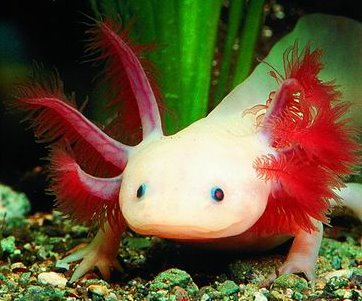
Buy Axolotls
Axolotl - Ambystoma Mexicanum Facts
Pronounced: ACK-suh-LAH-tuhl
Kingdom: Animalia
Phylum: Chordata
Subphylum: Vertebrata
Class: Amphibia
Order: Caudata
Family: Ambystomatidae
Genus: Ambystoma
Species: Ambystoma mexicanum
Origin: Mexico City
Albino: Origin Reared in captivity
Temperature: Keep in Unheated Aquarium 50-68F
Attitude: Frequent biter of tank mates
Issues: Will eat gravel
Security: None needed
Foods: worms, insect larva, crustaceans, fish, crickets
Supplements: None needed
Housing: At least a gallon of water per axolotl
Water: Clean water preferably hard
Introduction to Axolotls
The Axolotl is very unique. The axolotl is a type of salamander, native to Mexico. It's scientific name is Ambystoma mexicanum. The common pet or laboratory Axolotl refers exclusively to A. mexicanum, although in Mexico the term Axolotl is used in reference to several species of Ambystoma, and is considered an edible food source.
The Axolotl is neotenic, meaning that it doesn't routinely undergo metamorphosis from the larval to adult form, as happens with most other salamanders. Instead, the larval form (with gills) becomes sexually mature and reproduces, maintaining a strictly aquatic life style. Under some circumstances, the Axolotl can undergo metamorphosis into a terrestrial from, although this can be stressful on the animal.
The Axolotl has amazing regenerative abilities- if injured, even to the point of losing a body part, the Axolotl will heal readily and even regenerate lost bits. Because Axolotls have the ability to regenerate lost body parts, axolotls are probably one of the most scientifically studied for this reason. They are fairly hardy creatures that can be expected to live up to 10-15 years with attention to proper care, particularly with respect ot water quality. Can grow up to 12 inches. Weight is from 2 to 8 oz. Their skin and gills are very sensitive and quite soft, so handling is not recommended any more than is necessary. Because they can exchange air through moist skin, they can survive outside of water for short periods, as long as their skin is not allowed to dry out.
Juvenile axolotls can be cannibalistic towards each other, so they are best raised in separate enclosures. Adults can potentially be housed together but watch for cannibalistic tendencies. Of course, if a body part gets bitten off by a tank mate, an axolotl can regenerate it over time.
Buy, For Sale, Selling, Price, Purchase, Cost, Sale, at;